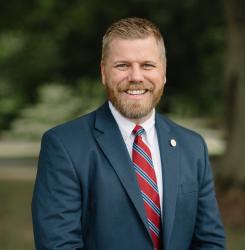The Conductor by Caleb Franz conveys the fascinating story of the Reverend John Rankin of Ripley, Ohio, a highly influential figure in the abolitionist cause of the 19th century. Rankin’s story is largely unknown, overshadowed by the more celebrated figures of the antebellum period and the Civil War. But Franz hopes to reframe the story of abolition. “We cannot hope to fully understand how slavery was abolished,” Franz writes, “without first understanding the role played by this rural Presbyterian minister.”
Rankin was a devout man who possessed moral clarity and a sincere faith that was strengthened by the difficulties of frontier life. He attended Washington College in Tennessee and was mentored by the president of the college, Rev. Samuel Doak. In 1816, he met and married Doak’s granddaughter Jean Lowery, who became an abiding source of support throughout their ministry.
Rankin is best known for his collection of letters addressing the evils of slavery, titled, Letters on American Slavery, which gave abolitionism “an intellectual foundation.” In Franz’s estimation, “what the Federalist Papers did for the Constitution, Rankin’s letters did for abolitionism.” When the political leadership of his time danced around the issue of slavery, Rankin was one of the earliest figures in the country to take it head on. From his perspective, slavery was “the ultimate sin—an absolute disgrace to the Creator.” Rankin’s home was a strategic stop on the Underground Railroad, and his life and writings influenced many in the abolitionist cause, including William Lloyd Garrison, Harriett Beecher Stowe, and Ulysses S. Grant.
As Franz tells Rankin’s story, several themes emerge. First, Rankin’s life and ministry was focused on the cause of liberty for all people. Once the nation was unified in the aftermath of the American Revolution, the “romantic visions of liberty and justice” evolved into deep-seated divisions. As these divisions become more entrenched through the 19th century, Rankin remained steadfast: “The God-given right to liberty drove every action.”
His struggle for liberty was ignited when he received a letter from his brother, John Rankin, letting him know he had purchased slaves. Rankin knew that the sin that caused his brother to betray “the foundational principles of liberty and humanity was an illness that infected hundreds upon thousands of slave owners in the south.” Rankin decided to respond publicly, and so from 1824 to 1825 he partnered with the editor of a publication called The Castigator to publish a series of letters (one per week) that address the evils of slavery from Scripture and his experiences. The letters were successful in the narrow sense that his brother was convicted and set his slaves free, but the letters went on to have a much larger influence. A Quaker in New Jersey worked with Rankin to reprint and distribute them under the title “Rankin on Slavery.” The letters then made their way into the hands of William Lloyd Garrison, shaping his thoughts on the subject. Through these letters, Garrison considered himself a disciple of Rankin, and the two would be constant friends throughout Rankin’s life, even though they did not always agree on specific strategies toward abolition.
Rankin also fought for the cause of liberty in other ways. He frequently organized and participated in anti-slavery societies and was an active conductor on the Underground Railroad. In 1815, in Jefferson County, Tennessee, Rankin organized the first anti-slavery society. It did not last long; he realized quickly that he needed to relocate to a free state to continue speaking out against slavery. Consequently, he moved his family to Ripley, Ohio, and built a home perched atop a hill just outside the city that was known popularly as Liberty Hill and that served as “a beacon of hope for fugitive slaves.”
In the aftermath of the atrocities of the Civil War, Rankin reflected on the fact that liberty came at a great cost. “I lived to see four million slaves liberated,” Rankin lamented, “but not in the way I had long labored to have done it.” Rankin had six sons and one grandson fight for the Union, and all of them survived the war; many others were not so fortunate.
The virtues of faith and fortitude comprise a second theme that emerges from Rankin’s story. These values were instilled in Rankin through the Christian faith. John Rankin’s father, Richard Rankin, fought in the American War for Independence and was a very devout Christian. He settled in East Tennessee with the rest of the Rankin family, and “strong character” combined with “biblical teachings” to provide the domestic context in which Rankin was reared.
Throughout the biography, the question of authority lingers. From an early age, Rankin’s parents instilled in him a love for learning and instruction from the Bible. His parents viewed it “as their Christian duty to possess a deep understanding of their own faith, to defend it and pass it on to their children.” His father led an unswervingly moral consistent life that left a lasting impression on Rankin. His father was “consistent in his church attendance, prayed frequently, and valued the integrity of his world.” His mother, too, “was steadfast in her faith” and opposed vices, such as alcohol, that were the root of many social problems.
The Rankin family faith was in a strict Calvinist mold that valued “reason, reflection, and reservation,” which was challenged by the wave of emotionalism sweeping through the Second Great Awakening. The awakenings taught him an important lesson: the need for sound doctrine. Without sound doctrine, “a passionate man could bend the Word to say anything he wished.” This lesson would prove useful when engaging the pro-slavery arguments from those who believed it was God-ordained. Rankin felt that, without a right view of God and doctrine, there was little hope of guiding people in a right moral position. He believed that a “lack of biblical literacy and rise in doctrinal inconsistency… would only lead to a twisting of scripture into whatever suited the will of men.” Any biblical defense of slavery, Rankin argued, “could be traced back to misapplied theology.
To help instill the theological and moral vision of the Scriptures, Rankin served his church, wrote other books on theological and catechetical topics, and taught courses at nearby Ripley College. Rankin’s voice of moral authority came at a critical time, when the country needed it most. His books include A Present to Families, which serves as a guide for parenting children, and An Antidote for Unitarianism, which defends the traditional doctrine of the Trinity. He also composed a catechism, entitled, A Catechism for Free Workman, during the Civil War to help explain the reason for the war. Among his famous students at Ripley College was none other than Ulysses S. Grant, who was influenced by Rankin’s abolitionist ideas.
In the end, what Rankin desired most was to see the country flourish by eliminating slavery and calling people to the higher path of the Christian spiritual life. When Rankin first arrived in Ripley, he found a small village “infected with infidelity, Universalism and whiskey retailers.” He knew the power that “faith and religion played in people’s lives, both privately and publicly,” so he was committed to moral reform. It took time, and Rankin nearly quit the ministry until Jane intervened, but Rankin’s presence and persistence eventually helped guide the town toward a more virtuous community. A good example of this involved the construction of Rankin’s home in Ohio. Rankin hired all his laborers personally, which included both black and white men, and required that they lead moral lives so long as they were in his employ. He also wanted them to understand that free labor was empowering.
But Rankin’s life was not easy, and he was no saint. And that is also what makes his story compelling. Money was a constant source of struggle, and he was plagued by debt. Rankin’s life was often under threat, and at times he even had an assassination bounty on his head that was raised at least once to $3,000—dead or alive. On one occasion, his barn was set on fire to draw out his family so they could be shot.
Amid all these struggles, his home remained a key stop on the Underground Railroad: “Over 2,000 fugitives came through Rankin’s station on Liberty Hill in their northward journey,” making it “one of the most active stations on the entire Underground Railroad.” This activity meant that he and his family lived under constant threat. One good example: On February 17, 1840, when only Jean Rankin and their 17-year-old son, Samuel, were home, five armed men approached the house with two bulldogs, hunting fugitive slaves they believed were inside. With a baby on her hip and young Samuel holding a loaded gun, the Rankins faced a standoff with the men. After words were exchanged, other people from the town showed up to defend the Rankin family; the men eventually left, but only after an agreeable search.
These and other stories made it into Harriet Beecher Stowe’s Uncle Tom’s Cabin. Harriet’s father, Lyman Beecher, was president of Lane Seminary in Cincinnati, not too far from Ripley, and she married a professor at Lane Seminary, Calvin Stowe. Adam Lowry Rankin, Rankin’s first son, attended seminary there, and Stowe was one of his most influential professors. When Harriet published Uncle Tom’s Cabin, she drew upon stories she heard from conductors on the Underground Railroad in Cincinnati and Ripley. For example, one story involves a woman named Eliza who made it across the river to a large white house; this bears a striking resemblance to the true story of a woman with the same name who sheltered at Rankin’s house on her journey north to Canada.
Rankin’s story remains inspiring to this day, and The Conductor serves as a reminder that “not every significant historical figure is a household name.” There have been many more people like Rankin, heroes who have largely gone unnoticed, men and women “who led extraordinary lives that influenced countless individuals and helped build a freer society—often at great personal cost.” These kinds of people have the courage and fortitude to live by their convictions and to work toward a vision of life that helps people flourish.
While this biography is a straightforward accounting of Rankin’s life and filled with many more details and compelling stories, it nevertheless leaves the reader with two lingering questions: What are the moral issues facing our generation? and How can Christians respond to them with the same kind of faith and fortitude? Rankin turned to the Scriptures and relied on sound doctrine, knowing that the theological and moral vision he found there could guide him. That might be the best place for us to start, and I hope that we, too, can find the courage to live by the teaching we find there.
Finally, anyone interested in American history, especially the antebellum period or the events surrounding the Underground Railroad, will enjoy this book. John Rankin’s life is a story worth reading and remembering.

